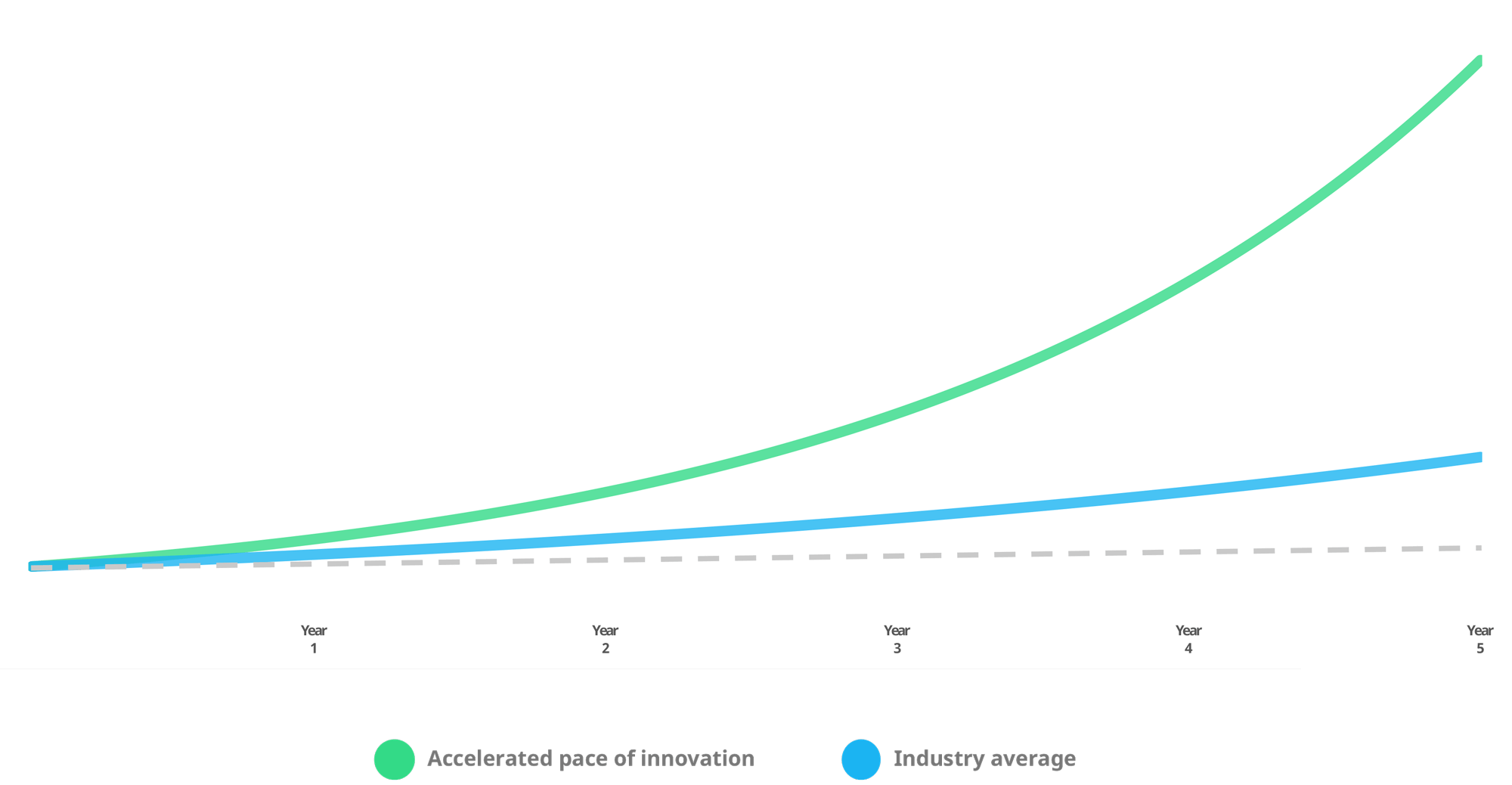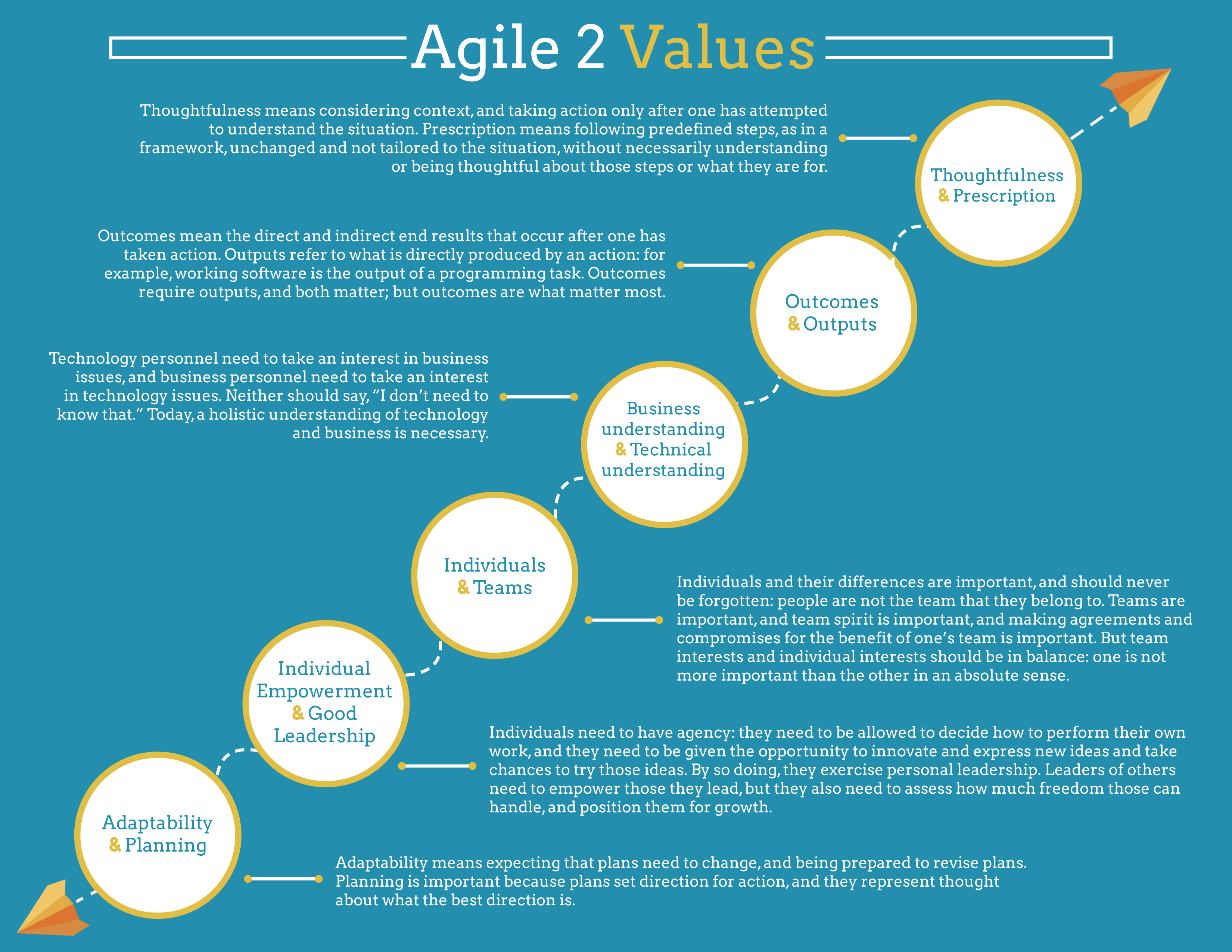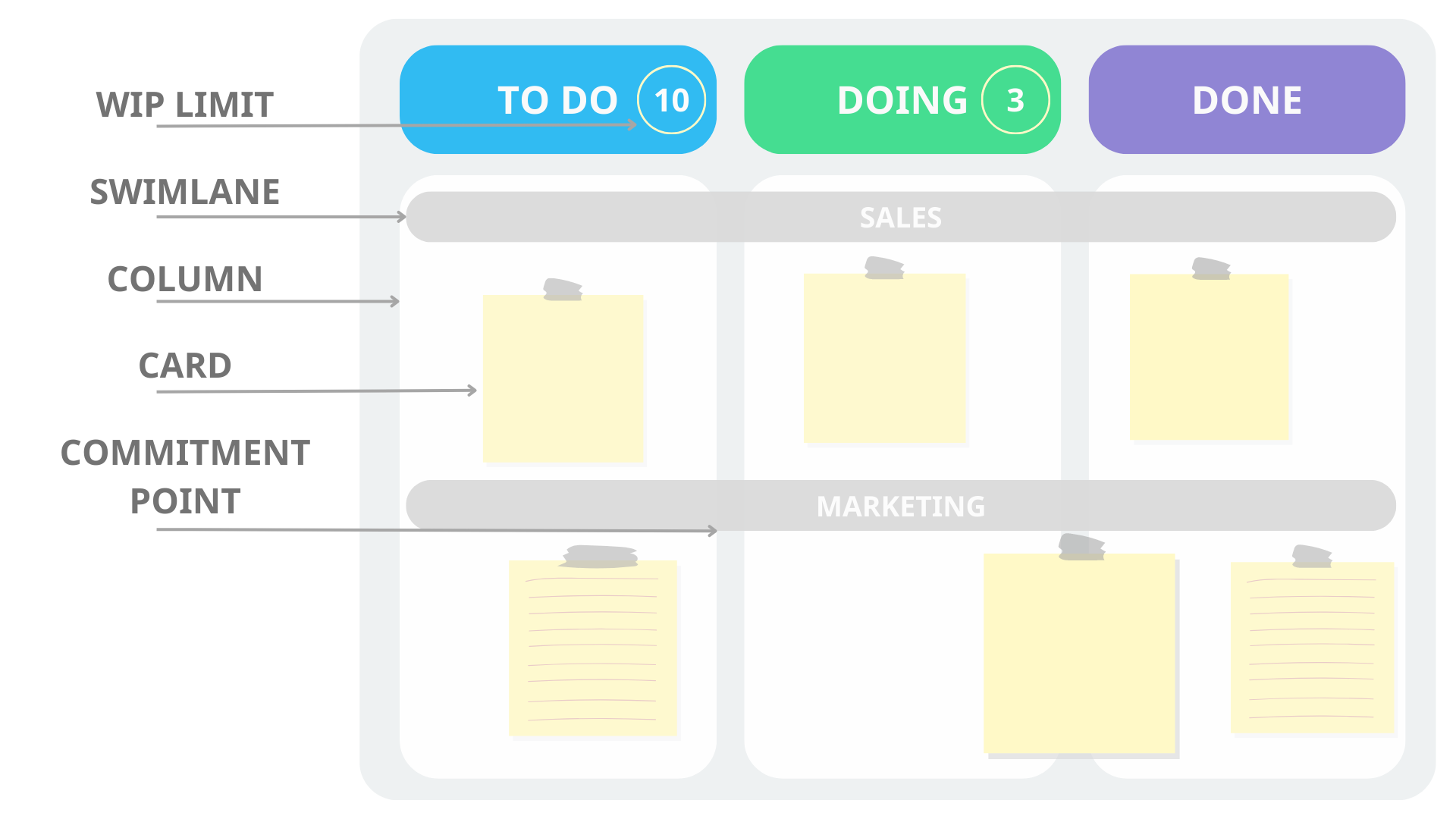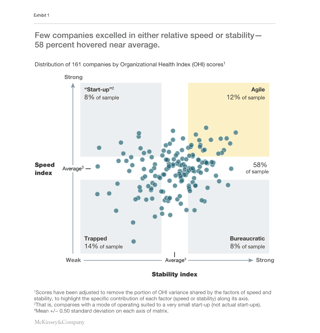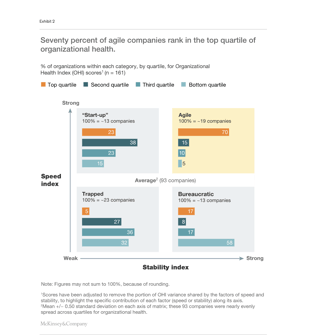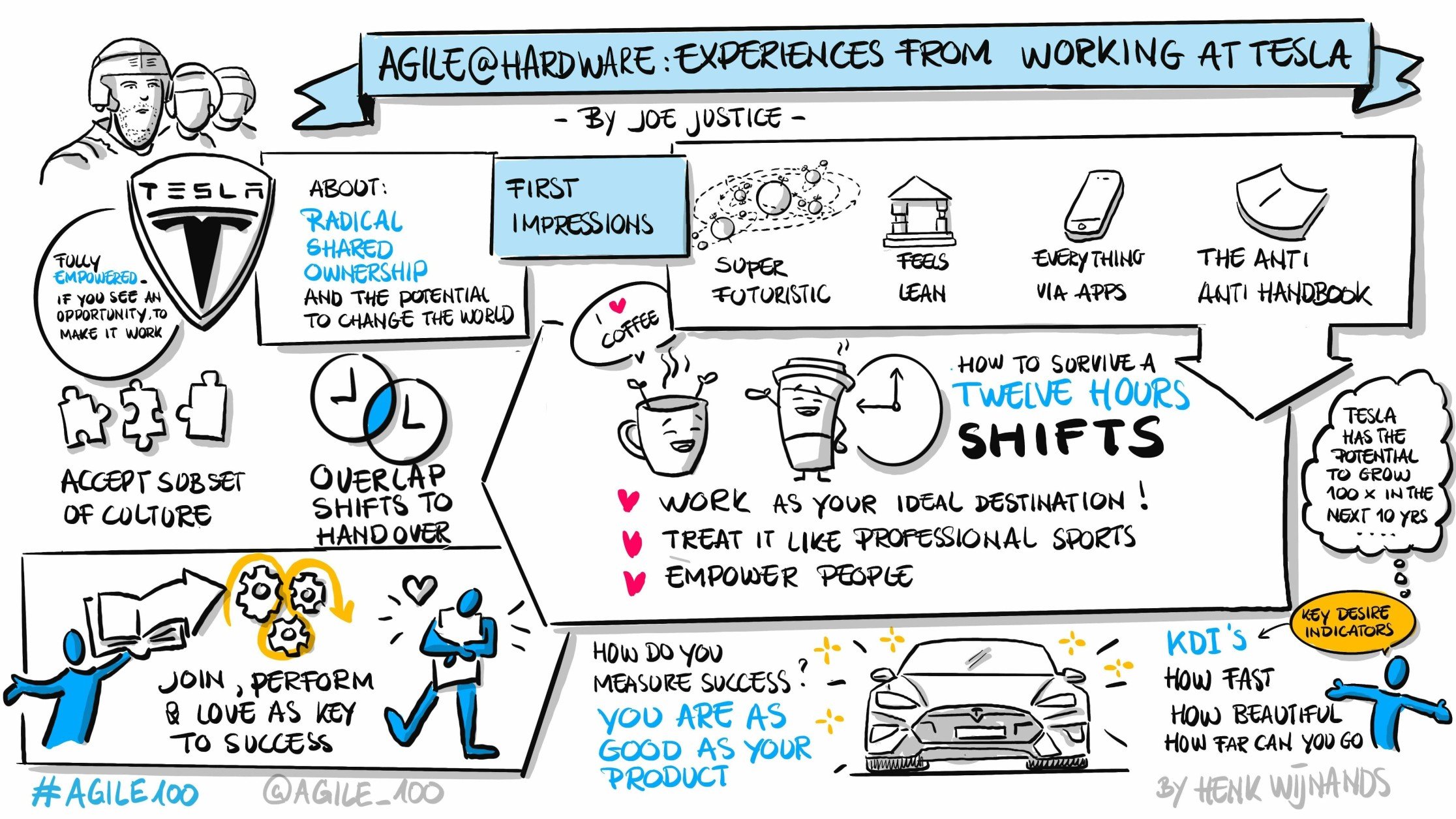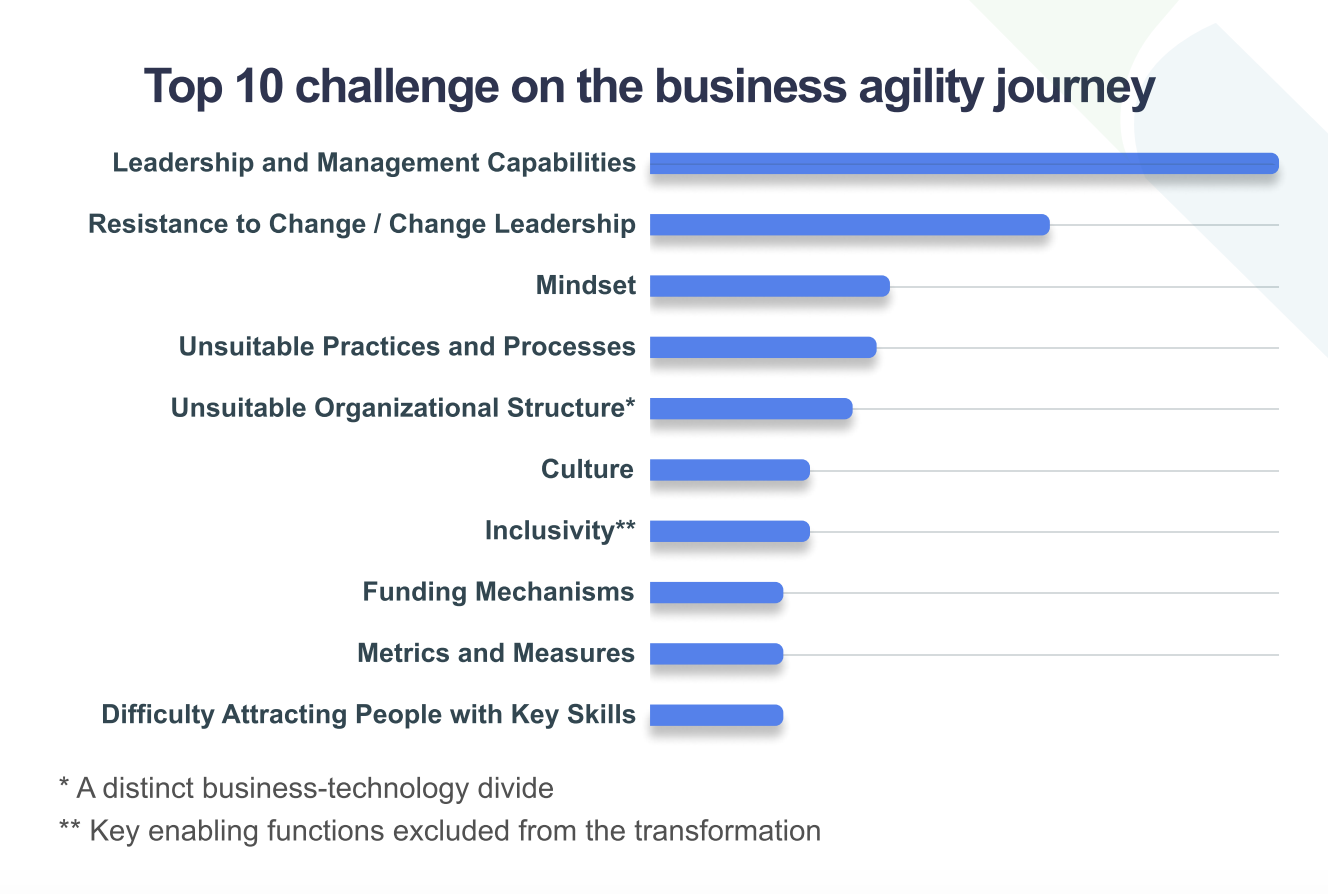Agile Innovation Management: The Complete Guide to Business Agility as a Driver for Innovation
Research reveals that 90% of executives recognize the critical importance of agility for their company's future success, with 96% emphasizing the need to increase agility in the future. What’s more, agile companies grow revenue 37% faster and generate 30% higher profits than their non-agile counterparts.
Incumbents are shaken by the highly dynamic environment they operate in, and they are too slow to respond to disruptive changes. 52% of companies in the Fortune 500 have either gone bankrupt, were acquired, or ceased to exist.
An AEIU survey, 27% of respondents cited their organization's lack of agility as a competitive disadvantage in anticipating marketplace shifts. Unfortunately, it’s not enough to be better and stronger, you also need to be faster to swiftly adapt to the market race.
Based on our experience in working with top innovators, and on market insights and trends, we can see that the future of innovation management is agile. What does this mean, and how does it concern you, the ambitious innovator?
We will provide all the answers in this article, a comprehensive guide to agile innovation management and the first in a series dedicated to business agility and agile innovation.
We'll first frame the major concepts, explain the thinking behind them and then we’ll provide practical tips and answers to big questions.
As with many of our articles, we seek to provide a comprehensive understanding of the topic, while also bringing forward practical advice which you can take into your everyday work. That being said, we advise you take your time with this one, bookmark it and come back to it to get a full grasp of the subject or to get more clarity.
Table of contents

Understanding Agile Beyond Software Development
Let’s start untangling the intricate connection between business agility and innovation management by shedding some light on all these terms: innovation, innovation management, agile and business agility.
Innovation is a highly debated topic. You might be sick of hearing this buzzword everywhere, but whether you choose to use it or not, the concept behind it is here to stay.
The short definition of innovation comes from the Merriam-Webster dictionary: innovation is "the introduction of something new."
This is an oversimplification, so we have to take it one step further to explain the nuances.
Innovation is not just about generating and implementing new ideas. While these ideas can refer to products, services or processes, adding innovation to the mix means that you bring about positive change and create value.
Innovation is about generating and implementing new ideas while bringing about positive change and create value.
Through innovation you should identify new opportunities that can be transformed into tangible outcomes that address unmet needs, solve problems, or improve existing conditions.
To achieve these results, you need to manage a series of activities that are involved in the process of introducing those new ideas. These activities can range from ideation, development prioritization, evaluation, to implementation and launching of new products or introducing new processes. This is what we call “innovation management”.
So, innovation management is about driving business growth through the introduction of new ideas and solutions. How you go about all these activities is what makes innovation and innovation management so difficult.
Innovation management is about driving business growth through the introduction of new ideas and solutions.
The challenge is not only in managing all these activities to pursue innovation, but also in doing it fast.
Here, we refer to the pace of innovation, which plays a crucial role in sustained business growth.
In a nutshell, the pace of innovation is the speed at which an organization can improve their existing products and services and their ability to develop them while capturing the needs of the constantly evolving markets.
Your rate of improvement (so the pace of innovation), has compounding, exponential returns and thus gives a clear competitive advantage.
Why are we talking about the pace of innovation? Because it goes hand in hand with the agile mindset, which in the past decade has developed into the more holistic approach, business agility.
Where does agile come from?
"Agile" typically means being able to move quickly and easily, being nimble or adaptable in response to change or challenges.
Agile as a business concept emerged in 2001 with the “Agile Manifesto”.
At its core, agile refers to a set of twelve principles and four values intended for teams that work on software development. It started as a manifesto, but the brains behind it never imagined that their vision on how to better develop software would play such a pivotal role in management at an organizational level.
This is, in a nutshell, the 2001 version of agile:
These are the four values of the Agile Manifesto. The idea is that what is on the left should be valued more than what is on the right.
- Individuals and interactions over processes and tools
- Working software over comprehensive documentation
- Customer collaboration over contract negotiation
- Responding to change over following a plan
Then, there are the twelve principles behind the Agile Manifest that the signatories followed.
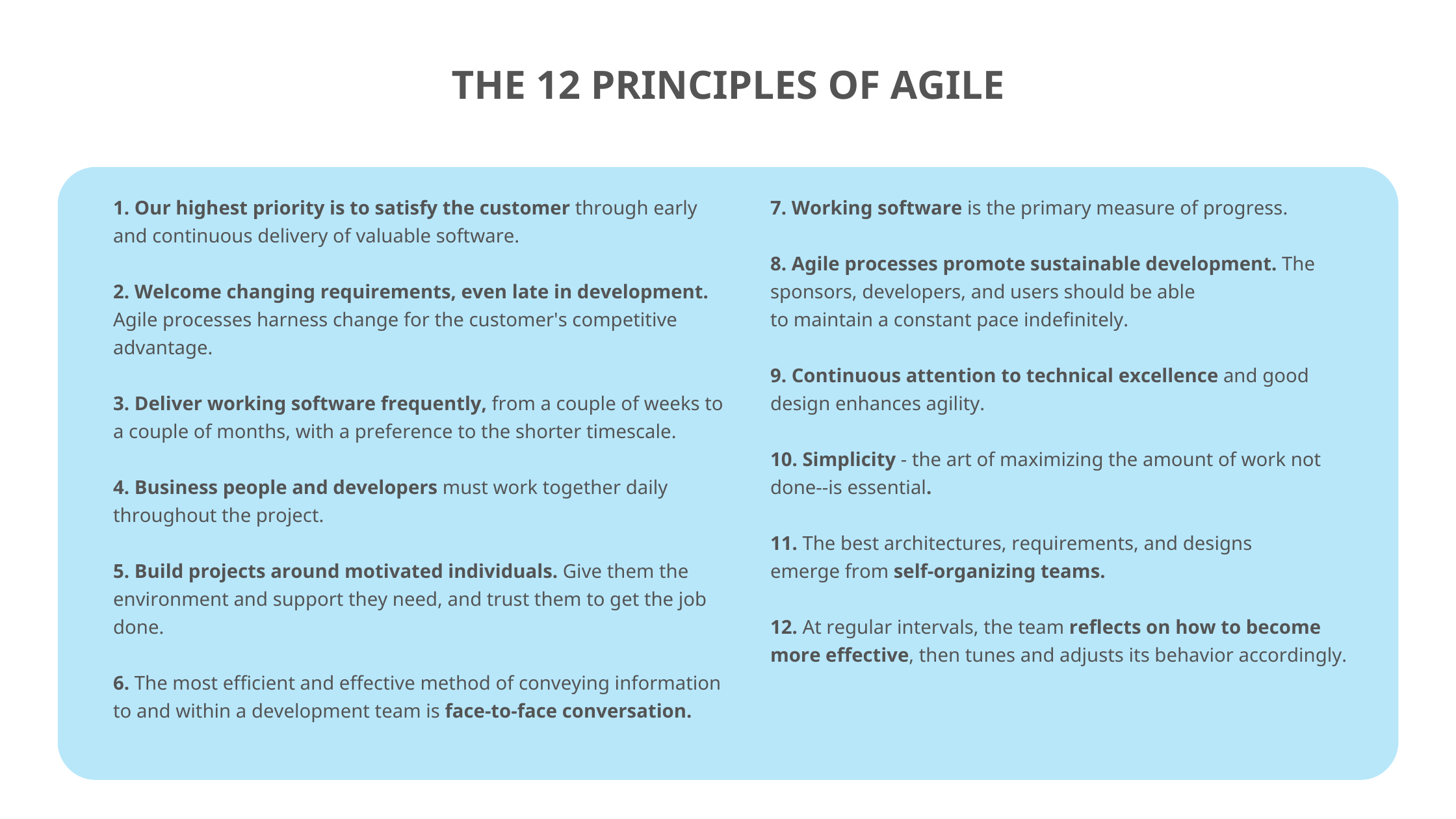
So, this was the spark that started the agile fire. It’s also the basis for some of the methods identified as agile.
Today, "agile" left the dark chambers of software development to capture the attention of leaders across many industries.
These days there are countless frameworks and practices that ride the agile wave. We won’t go down that rabbit hole because some of those frameworks evolved from self-serving business ambitions and can create more confusion than provide real solutions. We believe it’s more important to understand the thinking behind the agile concept, before deciding what methodologies are fit for purpose.
Agile 2.0
The past two decades have brought massive changes and the agile principles had to evolve to keep up with current times.
Agile 2.0 is the next iteration which comes from different authors who want “agile to pivot”. Given today’s use of agile and how it has been growing outside of its initial purpose, the initiative is understandable and laudable.
Agile 2.0 is more anchored in today’s digital world and puts greater emphasis on some areas that were missing or misunderstood in the first version.
It's also more balanced and encourages a more holistic approach. For example, even though the first manifesto does not incite chaos by making the case of self-organizing teams, it fails to address the importance of leadership, which agile 2.0 wants to rectify. To get a better understanding of agile 2.0, you can read the principles on the dedicated page.
To summarize, “the agile way” refers to the ability to respond to change, adapt, build things in smaller cycles, get feedback, and unveil new opportunities.
“The agile way” refers to the ability to respond to change, adapt, build things in smaller cycles, get feedback, and unveil new opportunities.
Agile is often referred to as a methodology. But if we consider its evolution, being agile is a mindset and a way of thinking. At a practical level, it does include a series of frameworks or methodologies that facilitate agility in project management.
So, how did the agile movement evolve into business agility and why should organizations strive to achieve it?
Why Business Agility is More Relevant than Isolated Agile Practices
Agility promotes flexibility, collaboration and continuous improvement. It’s about adapting and responding quickly to changes. This is why it also helps increase the pace of innovation. Of course, easier said than done.
We have seen in the past twenty years how agile has outgrown its software development box. The problem is that most organizations that want to be agile are trying to fit a square peg in a round hole. This leads to frustrations especially on the receiving end, when employees are forced into these “agile ways” even though leadership did not set the stage for agile in the first place.
Instead of fixating on agile methods, the focus should be on how to scale the approach at a higher level through business, organizational and enterprise agility. They might seem one and the same thing, but there are nuances that differentiate the three.
While business agility focuses on operational responsiveness, organizational agility emphasizes cultural and structural adaptability, and enterprise agility encompasses a broader perspective, incorporating external relationships and ecosystem dynamics in addition to internal capabilities.
In all three scenarios, achieving an extensive agile transformation is a highly complex journey and requires a top-down approach. However, it doesn’t mean that agility can’t also be achieved bottom-up, outside the IT department. In our work with customers, we see many innovation champions who put the wheels in motion through their determination and commitment to embrace agility.
Even though the agile concept is used as a badge of honor by many organizations, it’s still highly misunderstood.
That's why it’s also important to understand not just what agile is, but also what is not.
What is NOT Agile
Scaling agile thinking organisation-wide it's very difficult and hard to achieve. One reason is the lack of direction. Leaders and managers rush into methodologies and frameworks that sound good because others seem to be successful in implementing those. But more often than not, they forget to ask themselves why they want to be agile in the first place. Is it for the right reasons? Is there a good understanding of agile before bringing on board an agile coach?
Using Kanban, organizing Sprints, and hiring Scrum Masters will not automatically make you more agile. It’s important to understand agile holistically and put it into context before getting to the actual tactics and tools.
Start by asking yourself, what do you want to achieve, and what problems you want to solve with agile?
If your goal is to increase efficiency, deliver more or faster, increase productivity, or quality, there are plenty of other methods that can help you achieve this. Agile can contribute to these, but it’s not a prerequisite.
Agility is primarily about adaptability and changing conditions. So, the main reason for considering the agile approach should be market responsiveness: your organization’s ability to adapt rapidly to changes that are happening in the market.
The main reason for considering the agile approach should be market responsiveness.
Without clearly understanding the above, it’s easy to see how, for many organizations, agile became synonymous with processes like scrum.
Just to give a bit of context, Scrum is the most popular method (even though it precedes the Agile manifesto) used now by agile practitioners. It’s an iterative framework that brings small teams together to find adaptive solutions for complex problems.

A scrum process is built around product innovation and works best when there is a lot of uncertainty, and you don’t know which way your product should go.
In Scrum, work is organized into short iterations called sprints, usually lasting 2-4 weeks, during which a cross-functional team works to complete a set of tasks or goals. Sprints have been adopted by other departments too, not just those working on product development.
But whether these can be successfully implemented outside of software development and scaled to other departments, is still a matter of debate. We’ll explore the reasons behind this in the next section where we dissect the challenges and pitfalls of agile.
Bottom line, scrum is most suited for exploration and validation of assumptions. Scrum is not about speed, efficiency, and predictability. If you’re in a highly exploratory environment Scrum is a valuable practice.
Then there are those teams that proclaim their agility through Kanban. We explained the tool in greater detail here, where we show how it’s used to improve flow efficiency and optimize operations.
While it can be a highly valuable tool within the agile transformation, Kanban on its own is not enough to increase agility.
So, while these are very popular agile practices, useful in their own right, they don't have the power of embedding agility at the core of the business.
Now, what does this all have to do with innovation management and how can you actually drive agility to innovate?
How Agility Enables Innovation
Agility is an enabler for innovation. The pace of innovation, while not easy to achieve, has become the ultimate competitive advantage as we all need to adapt quickly to evolving environments, the digital age and increasing pressing needs.
The reality is that agile thinking is changing the world whether we decide to adopt it or not.
You should not aim to do more work in less time, but to work smarter and generate more value with less work.
Those who succeed at this are ahead of the game. McKinsey research suggests that agility is a critical factor for organizational success.
The Organizational Health Index (OHI) assesses various aspects of organizational health, including agility, and examines how these factors correlate with business success. An increased organizational health is linked with more resilient, adaptive, and high-performing organizations that can better navigate complexity, drive innovation, and achieve strategic goals.
What's more, agile organizations are best at balancing both speed and stability, and these are also the companies that rank highest in the organizational health index.
The research goes even deeper and identifies a series of management practices that differentiate the most from the least agile companies.
As you can see, there’s more to business agility than meets the eye and a few sprints just won’t cut it.
However, if we look at the agile principles, there are several ways in which they can enable innovation:
- They bring an empirical process control approach, which emphasizes transparency, evaluation, and adaptation.
- They enable experimentation and learning as teams are encouraged to test hypotheses, validate assumptions, and learn from both successes and failures. This experimental mindset is essential for innovation.
- They are about adaptive planning processes that allow teams to adjust their priorities, strategies, and product roadmaps based on emerging opportunities and threats.
- They emphasize customer-centricity. By focusing on delivering value to customers through continuous delivery and customer feedback loops, you make sure your innovations meet real market demands and solve genuine problems.
- They encourage cross-functional collaboration and self-organizing teams, bringing together diverse perspectives and expertise.
Examples of Agile Organizations
To identify the trademark of agile organizations, let’s first look at some examples of companies that have adopted and adapted the agile mindset and principles to become leaders in innovation.
Space X and Tesla
Both Tesla and Space X are great examples to showcase the tenets of agility. They have gone beyond the Agile Manifesto of four values and twelve principles. Their lightweight model is a new agile that works organization-wide and makes innovation happen faster.
At these companies they didn’t simply implement methodologies and frameworks, instead they made things their own way, with the ultimate goal of innovating faster. But beyond innovating products, Tesla also innovates the way companies can be run.
Here’s how Tesla and Space X use agile principles adapted to their business model to get innovations rolling faster:
- Employees self-organize, self-allocate and re-assign their work. They are organized in small teams of less than five people, a mob. In the traditional companies the managers tell subordinates what to do and what is in the scope of their role. Tesla is truly a flat organization.
They use the Digital Self-Management, a set of tools powered by AI. This helps them make decisions without the input from a manager, which basically removed completely the manager role within Tesla. - Cross-functional collaboration. Elon Musk is famous for his knowledge on rocket building, battery technology, AI, automotive manufacturing, etc. Not everyone can accumulate this amount of knowledge, nor should they feel that only by working sixteen-hour days can they be successful.
However, what you can learn from this is the cross-functional approach. Elon Musk might be a different kind of smart, but he couldn’t accumulate all this knowledge without actively participating and joining many teams on the factory floors. - Iterative design through quick cycle times. Both Tesla and SpaceX follow a process of iterative design, where prototypes are built quickly and continuously improved based on feedback.
By eliminating any unnecessary barriers and friction in decision-making, development, and innovation processes, they achieve extremely high speed and still fulfil all those qualitative requirements for their products.
Thanks to these practices culminating in continuous automated testing, they reportedly have the ability to update software to production 17,000 times a day – with 50x fewer software engineers than their competitors!
It’s also interesting to note that Tesla’s strict adherence to these agile practices has been imposed on their suppliers too. Bosch, a German company using the more traditional waterfall project management model, has implemented in parts of their company the agile model. They change and improve the products they deliver to Tesla on a weekly basis thanks to dedicated, agile divisions within Bosch.
You can learn more about the Tesla agile way from this podcast where Joe Justice, who operated Agile at Tesla, goes in much more detail.
Amazon
Even though Amazon doesn’t claim to be agile in the traditional way, it does use many of the agile principles and it is considered one of the pioneer companies in this area.
Of course, the bigger they get, the more challenges they face. They have a huge impact on other businesses, society and even the environment, so understandably they also face a lot of backlashes. These are all undoubtedly important matters.
But for the scope of this article, we are not referring to the parts of the company that are run in a traditional manner, but to the capabilities that make agile possible within certain areas of the organization.
- Small, self-organizing teams: Amazon organizes its teams into small, autonomous groups called "two-pizza teams," which are small enough to be fed with two pizzas. These teams have end-to-end responsibility for their projects, allowing them to move quickly and make decisions independently.
- Customer-Obsessed Culture: Amazon prioritizes customer satisfaction above all else, with Bezos famously stating, "We see our customers as invited guests to a party, and we are the hosts. It's our job every day to make every important aspect of the customer experience a little bit better." Everyone in the company should be a good host and prioritize the customer. This is not just the job of management, sales or marketing.
- Data-Driven Decision Making: to feed into this customer obsession Amazon relies heavily on data to drive decision-making at all levels of the organization. Through its robust data analytics capabilities, Amazon gathers insights into customer behavior, market trends, and operational performance to provide real customer value.
- Day 1 Mentality: Bezos instilled a "Day 1" mentality at Amazon, emphasizing the importance of maintaining a startup-like culture of innovation, agility, and willingness to take risks. This mindset encourages continuous experimentation and adaptation to stay ahead of the competition.
ING Bank
The next example serves as a cautionary tale.
ING, a global financial institution from the Netherlands, is an example of how the right reasons for adopting agile practices can still lead to failure if the execution is flawed.
In 2015, ING noticed changes in customer behavior due to trends in other industries and realized they needed to evolve as well.
Taking inspiration from the practices of tech companies, ING attempted to adopt agile methodologies. However, their approach may have drawn too heavily from other agile companies, such as Spotify, without fully considering their own unique context and needs.
What did they do, and why did it ultimately fall short in the long run?
ING's first step was to develop a strategy and vision for an agile transformation. They started small and expanded the new structures and ways of working across their headquarters within eight to nine months.
However, the transformation was too aggressive. ING dismantled most of its existing structures and created small squads instead. This required 3,500 employees to reapply for 2,500 newly defined positions within these squads.
What is the most important thing to learn from these examples?
In Doing Agile Right (HBRP, 2020) the authors remind us that "the best approach is not to choose agile over all other management approaches, but to learn when, where and how to use it in combination with other tools."The best approach is not to choose agile over all other management approaches, but to learn when, where and how to use it in combination with other tools.
The Tenets of Agile Organizations
Drawing from these examples and research from other organizations, we can summarize the five tenets of agile organizations:
- Purpose-Driven Mindset: Shift from a focus on capturing value to co-creating value with stakeholders, embodying a shared vision across the organization.
- Empowered Network of Teams: Transition from top-down direction to self-organizing teams with clear responsibility and authority, fostering engagement, innovative thinking, and collaboration.
- Rapid Learning Cycles: Embrace uncertainty and continuous improvement through iterative decision-making and experimentation, prioritizing quick adaptation over rigid planning.
- Innovation Culture: Cultivate ownership, empowerment, and customer-centricity, enabling employees to drive organizational success.
- Integrated Technology Enablement: View technology as integral to unlocking value and enabling responsiveness to business and stakeholder needs, leveraging advanced tools for seamless integration and rapid innovation.
Understanding the principles of agile organizations and their role in fostering innovation is crucial. However, it's equally important to acknowledge and address the challenges that you may face if you want to introduce these methods in your organization too.
The Challenges of Agile
Let's explore some common challenges of agile. To pinpoint these challenges, we can reference the 2023 Business Agility Report, which highlights the top 10 obstacles to achieving business agility. We’ll explain some of the most important ones, then briefly introduce fake agile, another interesting pitfall of agile.
-
Inefficient leadership
While not surprising, it’s interesting to see that the top two challenges of business agility are related to leadership. It’s understandable because leaders set the tone. Agile transformation should be led from the top to inspire and empower. This is very different from the top-down approach in the traditional way, where leaders rely on formal authority.
To address this, besides leaders’ development, the Business Agility Institute (BAI) also suggests creating incentives that promote collaboration and reward behavioral change that is tied to customer-centric behaviors, not to short-term financial goals.
-
Mindset and cultural change
These two are closely linked because you can’t change mindsets if you have the wrong culture.
Also, it’s not easy to change how people think, but behavior can still be influenced without being manipulative or restrictive. A culture of innovation is vital if you’re looking to innovate and achieve or maintain a leading position. It’s the foundation that really enables you to innovate systematically, and at speed.
An innovation culture should leave room for creativity, empathy, and freedom. We’ve written extensively about leading innovative teams and fostering a continuous improvement culture. They are interlinked and play a crucial role in making the shift from a fixed mindset that is not ready to adapt, to the growth mindset, curious to learn and evolve.
Creating the right culture for agile thinking to thrive isn’t impossible, it just takes a lot of dedication, persistence and hard work.
-
Fake agile
In short, fake agile refers to all the methods replicated by organizations where the agile mindset and thinking are missing. Just like with innovation theater, it’s easy to fall in this trap when you’re simply introducing a set of predefined frameworks without adapting them to your context.
Steve Denning explores this phenomenon and the ways it can creep in a company.
Fake agile can have different root causes.
- An overfocus on the branded methodologies like Kanban, scrum SAFe, XP, etc. Many of these frameworks focus on specific areas, mostly around project management, team organization and so on. They don’t provide a holistic approach to becoming agile and they can paradoxically become bottlenecks for agility.
- Limiting agile to software development. The authors of the first manifesto never thought of business agility, so it’s difficult to implement their principles at scale, in other areas. If you keep a narrow approach, you risk running into conflicts with the rest of the organization that is moving at a very different pace.
To avoid this, go back and reconsider the goal you pursue through agility. Are you seeing valuable, impactful improvements and results? Are you measuring the impact? How to go about these steps? This is what we explore in the next section.
Actionable Steps to Drive Innovation through Business Agility
We can't wrap things up without going through some of the key steps that should not be missed in an agile transformation journey.
Constancy of purpose
You might have heard of Edwards Deming and even used his PDCA cycle in your continuous improvement work. He is well known for his legacy in the field of quality management, particularly for his contributions to the improvement of production processes in Japan after World War II. To some degree, his work is also seen as one of the main inspirations for the agile movement.
Among his work, we can also find the "14 Points for Management," where Deming outlines how essential it is to have a clear and unwavering commitment to a long-term vision or mission.
He called it constancy of purpose. You can also call it your North Star. Regardless of the words you choose, it's important to set your goals and align all activities, processes, and resources towards achieving them. How to do this?
- Communicate the Purpose: Regularly communicate the organization's purpose, mission and goals as well as how agility contributes to achieving them.
- Define Goals: Clearly define objectives and goals that align with the organization's purpose. These goals should support the overall mission and vision.
- Empower Teams: Trust by default and enable teams to make decisions, take ownership of their ideas and work. Provide them with the autonomy and resources they need to innovate and deliver value.
- Measure Progress: Measure progress towards your goals, but also establish metrics that can measure your ability to be responsive. Regularly review and assess how agile practices are contributing to the overall mission.
- Adapt and Iterate: Embrace continuous improvement processes that align with your internal structures and needs. Encourage teams to experiment, learn, and iterate on their approaches.
Agile leadership
Adopt the ABC of leadership which drives innovation and makes the shift from “vertical ideology of control” to “horizontal ideology of enablement”.
Linda Hill, renowned professor at Harvard Business School, specializing in leadership and innovation makes a great point about the roles a leader should take if they want to drive innovation and agility.
Over time leadership evolved from a purely strategic role, to providing a vision that guides people in the same direction. More recently, research showed that a visionary leader is not enough. You need leaders that can also shape the culture and capabilities needed for people to co-create the future. This requires a different approach to leadership.
Research has identified that in order to lead an organization that innovates at scale with speed, you need leaders that fill in three different functions:
- the Architect - to build the culture and capabilities necessary to collaborate, experiment and work.
- the Bridger - to create the bridge between the outside and the inside of the organization by bringing together skills and tools to innovate at speed.
- the Catalyst - to accelerate co-creation through the entire ecosystem.
Here is Hill’s short summary on the ABC of leadership:
Another top voice is Steve Denning who has been an advocate of agile and agile management for years. He makes some great points about the agile mindset which requires a new way of running organizations.
For an organization to be truly agile, the so called industrial-era management needs to be replaced with digital-age management which is strongly driven by an agile mindset.
The traditional management style makes it hard for agile to work because the old command-and-control approach goes against the agile principles. The top-down approach is riddled with bureaucracy which obstructs visibility to the customer and the realities at the lower levels of the organization.
Some of the most successful and innovative organizations, like Apple, Google, and Microsoft understood this early on and shifted their focus to delivering customer value first, one of the agile principles. This required a change in mindset but also in the corporate culture, which is no easy undertaking.
To make this transition, Denning talks about five major shifts that companies need to make:
- From profit-focused to customer-focused goals.
- From direct reporting to self-organizing teams where management’s role is not to check on employees, but to enable them to do their work by removing obstacles.
- From bureaucracy, rules, and reports to work coordinated by Agile methods and customer feedback.
- Prioritize transparency and continuous improvement over predictability.
- Encourage horizontal communication rather than top-down directives.
While they are straightforward and make sense for most of us, these changes are maybe the hardest to make, especially for established organizations that are not used to challenging the status quo.
These big undertakings are what make agile possible at scale. But even if you’re not there yet, you can still apply the agile principles at a smaller scale to enable innovation.
Minimize complexity
Complexity is the enemy of agility. People in companies both large and small try to come up with the perfect solution, that often doesn’t exist in the first place, and only end up having solved the wrong problem.
On the other hand, if you were to simply move ahead quickly with something that creates real value and solves at least some of the problems, you’ll see which of your assumptions and concerns are real, and which aren’t. You’ll also see which problems you can work around, and which ones you simply must address directly.
This obviously eliminates a lot of uncertainty and reduces the complexity associated with solving the problem, which again helps you focus your innovation efforts on what matters – creating real value.
Thus, the bigger and more complex the problem, the more important it is to take this agile and modular approach that focuses on the speed of making tangible progress.The bigger and more complex the problem, the more important it is to take an agile and modular approach.
Conclusion
As we explained in our complete guide to innovation management, there is no single perfect way of managing innovation. Different companies have different approaches for innovation management.
However, the common thread of successful organizations are structures and processes that mitigate the somehow chaotic nature of innovation management.
In this article, we explored agile as a method to enable innovation and improve its management for sustained success. We don’t believe in quick fixes or miracle solutions. That’s why we made the case of agile as a mindset that should permeate every aspect of the organization.
You can still be agile without a Scrum Master or an Agile Coach. Of course, these can still be valuable additions, in the proper context. But you first need the right mindset, values, and principles to be prepared to adapt and respond to change.
Once you have these in place, you can start thinking of specific tools and methods that can help you enable agility. We’ve seen this happen with the use of Viima by organizations of all sizes, and from different industries. Small teams start using Viima for their own projects and processes and later roll out its use and introduce it organization-wide.
They use Viima boards to enable cross functional collaboration, run brainstorming sessions and collect ideas, they have continuous improvement projects and map out their process using the Kanban view, or work in small teams on specific projects that require transparency.
The point is that once you have figured out how to become more agile, you can explore suitable frameworks. You should keep it simple. Just like we do it with Viima.
You can start using it within minutes. With clear goals and objectives, you'll unlock its full potential.
Author's Note: This article has been revised for clarity and edited in May 2024 to provide more up-to-date information and context.



